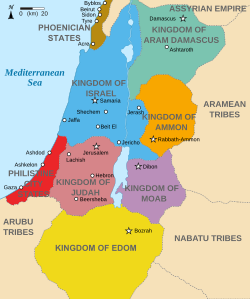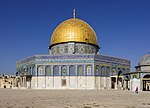
Back فلسطيا Arabic فيليستيا ARZ Филистия Bulgarian Pentàpolis filistea Catalan Pentapolis (Palästina) German Γη των Φυλιστιείμ Greek Filistea Spanish Filistia Basque فلیسطیه Persian Philistie French
Philistia | |||||||||
|---|---|---|---|---|---|---|---|---|---|
| 1175 BC–604 BC | |||||||||
 Philistia in red, and neighbouring polities, circa 830 BC, after the Hebrew conquest of Jaffa, and before its recapture by the Philistines circa 730 BC. | |||||||||
| Common languages | Philistine Canaanite Aramaic (from the 6th c. BC) | ||||||||
| Religion | Canaanite religion | ||||||||
| Demonym(s) | Philistine | ||||||||
| Government | Confederation | ||||||||
| Historical era | Iron Age | ||||||||
| 1175 BC | |||||||||
• Babylonian conquest of the Levant | 604 BC | ||||||||
| |||||||||
| Today part of | |||||||||
| History of Israel |
|---|
 |
|
|
| History of Palestine |
|---|
 |
Philistia (Hebrew: פְּלֶשֶׁת, romanized: Pəlešeṯ; Koine Greek (LXX): Γῆ τῶν Φυλιστιείμ, romanized: gê tôn Phulistieím) was a confederation of five main cities or pentapolis in the Southwest Levant, made up of principally Gaza, Ashkelon, Ashdod, Ekron, and Gath, and for a time, Jaffa.[1][2]
Scholars believe the Philistines were made up of people of an Aegean background that from roughly 1200 BC onwards settled in the area and mixed with the local Canaanite population,[3][4] and came to be known as Peleset, or Philistines. At its maximum territorial expansion, its territory may have stretched along the Canaanite coast from Arish in the Sinai (today's Egypt) to the Yarkon River (today's Tel Aviv), and as far inland as Ekron and Gath. Nebuchadnezzar II invaded Philistia in 604 BC, burned Ashkelon, and incorporated the territory in the Neo-Babylonian Empire; Philistia and its native population the Philistines disappear from the historic record after that year.
- ^ Anson F. Rainey (February 2001). "Herodotus' Description of the East Mediterranean Coast". Bulletin of the American Schools of Oriental Research (321). The University of Chicago Press on behalf of The American Schools of Oriental Research: 58–59. doi:10.2307/1357657. JSTOR 1357657. S2CID 163534665.
- ^ "The Philistine Age - Archaeology Magazine". www.archaeology.org. Retrieved 2023-12-29.
- ^ Sullivan, Benjamin M. (2018). "In the Shadow of Phoenicia". The Journal of Hellenic Studies. 138: 67–79, (70). doi:10.1017/S0075426918000058. JSTOR 26575919. S2CID 165940849.
- ^ John Noble Wilford (29 September 1992). "Philistines Were Cultured After All, Say Archeologists". The New York Times. Retrieved 20 May 2021.
I am willing to state flatly that the Sea Peoples, including the Philistines, were Mycenaean Greeks
© MMXXIII Rich X Search. We shall prevail. All rights reserved. Rich X Search